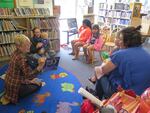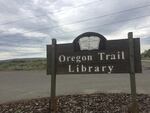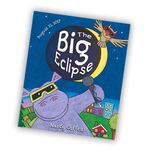
Nancy Coffelt reads from her new book, "The Big Eclipse"
April Baer / OPB
While the 2017 Solar Eclipse is a star-watcher’s bonanza and a great creative inspiration, it also provides teachable moments for the science-minded kiddos of Oregon. One educational book for children caught our eye: “The Big Eclipse,” by award-winning author and illustrator Nancy Coffelt, balances goofy, eclipse-glasses-wearing animals with lessons about science and safety.
The books are on shelves in 38 states and sold at the American Museum of Natural History in New York City, the Hayden Planetarium, and Yellowstone and Grand Teton National Parks. Coffelt and publisher Nancy Cuyler blew through all their copies in their first printing and are filing orders with a second. We caught up with them on a grant-funded tour of libraries in eastern Oregon, handing out free books and eclipse-watching gear, teaching kids to make pinhole viewers, and getting everyone excited about astronomy.
Boardman assistant librarian Claudia Gomez says readers of all ages have been asking for eclipse-related reading "on Facebook and when they come and visit the library. They just talk about how excited they are about the eclipse coming,” Gomez said.

Coffelt and Cuyler toured libraries in Eastern Oregon with the new book.
April Baer / OPB
Elaine Cuyler was working in the wine industry when she first heard the state was about to welcome tens of thousands of eclipse tourists.
“The question on a lot of people’s minds was, ‘Where are they going to stay?’” she said. “My question is, ‘Is everyone prepared to see it properly, and are they aware that this is a wonderful chance for their children to learn something about astronomy? Do they have their kids prepared?’”
So Cuyler had the idea: a kids book. But, she hesitated. Because of the illustrations, picture books are expensive to make. Publishers need to know their market.
“It had to be something teachers could use, libraries could use, parents could use as a resource,” Cuyler said. “Also something we could sell to the public, because I didn’t want to end up with 40,000 books in my basement.”
But when she realized the estimated tourist tally was closing in on 1 million people, Cuyler reached out to Nancy Coffelt, and “The Big Eclipse” was born. Cuyler actually quit her day job to publish and promote the book, and work on eclipse-related events.

Nancy Coffelt's artwork for the cover of "The Big Eclipse".
Courtesy of Orbit Oregon
We met kids ranging the elementary grades at Coffelt’s readings. Nicole Shelton from Irrigon, has one toddler and one school-age boy.
“I really wanted Clayton to see the eclipse,” Shelton said. “It’s an important event that doesn’t happen very often.”
Looking around at the large and small fry, you start to realize the challenges Coffelt and Cuyler faced. They were aiming to reach audiences of kids between the ages of 5 and 11. That meant holding the attention of smaller kids being read to, as well as older kids reading the book themselves.
Coffelt said her solution involved coming up with animal characters to engage the little ones.
“We came up with characters, the hippo and the owl,” Coffelt said. “Kids are going to think, ‘I am the hippo,’ or, ‘I am the owl.’”
In writing the text, she added extensive sidebars.
Related: OPB's Coverage Of The Oregon Solar Eclipse 2017
“That’s where most of the accurate number information is. We wanted the science of how eclipses work, but also how animals behave, and myths in history about eclipses. Those were fascinating,” Coffelt said.
A big part of the team’s motivation was safety. Coffelt says they spent hours thinking through the best way to get through to kids about how to watch, without scaring them to death about eye risks.
“For the longest time we went back and forth about glasses on or off during totality,” Coffelt said, “because we worried people would take them off to early or leave them off too long.”
Cuyler said the partial eclipse is a really interesting time to watch what’s happening, as the moon slips in front of the sun. But as you watch the sky darken, your eyes’ pupils are opening up. There’s actually more danger for the rays to damage an unprotected retina at that time. So Coffelt and Cuyler settled on a strategy: repetition. They’d reinforce the message with visual cues, like animals in safe viewing glasses on every page.
Coffelt and Cuyler spent so much time on research that they ended up with enough material for an extra activity book, sold separately.